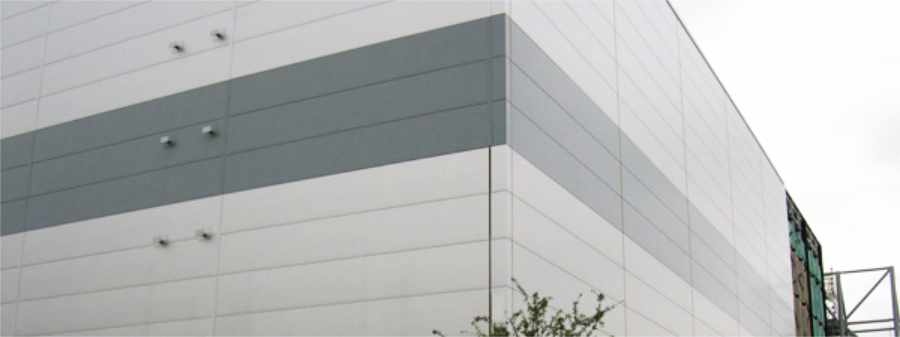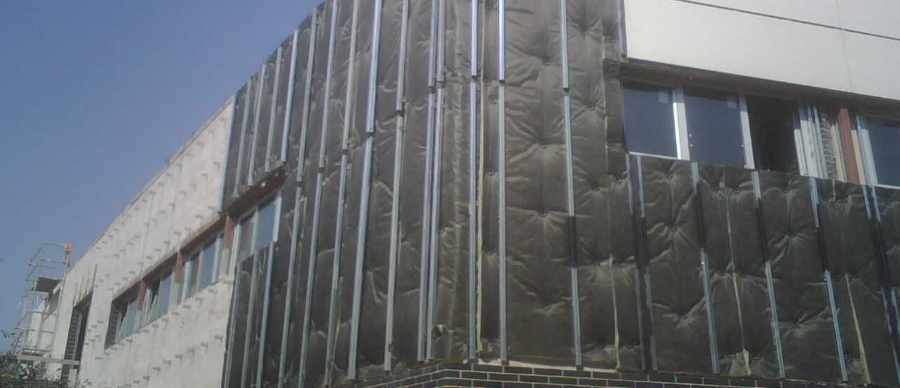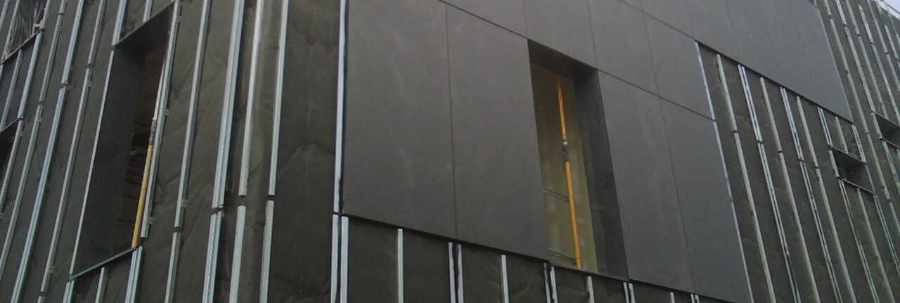Metal composite material panel systems MCM and MCP
Contents |
[edit] In brief
Metal composite panels (or metal composite materials, or MCM) are typically used in the external cladding of buildings as single system build-ups or as multiple layer build-ups, such as rain screens. They can be bent, curved, and joined together in an almost unlimited range of configurations with a variety of finishes, making them popular with architects and engineers of both simple and complex structures. The use of MCM panels and in particular Aluminium Composite Materials (ACM) has, however, in recent years been seen to pose significant fire risks, particularly where manufactured with an untreated polyethylene core, and as such they have been banned for use in high-rise buildings.
Metal composite materials (MCM) are defined in approved document B of the building regulations as '...any panel or sheet, having a thickness of no more than 10 mm, which is composed of a number of layers, two or more of which are made of metal, alloy, or metal compound, and one or more of which is a substantial layer made of a material having a gross calorific value of more than 35 MJ/kg when tested in accordance with BS EN ISO 1716. A substantial layer is defined as a layer that is at least 1 mm thick or has a mass per unit area of at least 1 kg/m2.'
see also Sandwich panel,
[edit] Background
MCMs first emerged commercially in the 1960's and have continued to be used as wall cladding, in cornices and canopies, and for joining areas between other building materials such as glass and precast panels. Initially, many examples employed singular extrusions of bonded sealed cladding units with a tongue and groove system, cut to length and clipped above one another with the lips externally, protecting the exposed edges of insulation, reducing thermal bridges, and sealing from the weather. These are often referred to as insulated metal panels. These types of systems are single-layer systems and are often used for buildings having lower thermal requirements, such as earlier industrial buildings, which became less popular as thermal performance requirements increased.
MCMs were later developed as a component of two or more part, thin rainscreen systems, installed within a ventilated frame system, protecting a separate layer of insulation beneath. Rainscreens could improve thermal performance over single-layer buildups through an increase in thermal resistance at the surface, preventing risks of damp penetration into the insulative layer, reducing thermal bridges, and allowing flexibility in the selection of component parts, the buildup depths, and selected finishes.
[edit] Sandwich solution
In general, both single-layer and rainscreen systems comprise of two metal skins bonded to an insulating core, forming a composite sandwich panel. The combination of the two can create a rigid, lightweight rainscreen cladding system or a single modular cladding system (often referred to as an insulated metal panel). In the case of the rainscreen cladding, the rigid core is considerably thinner, gaining rigidity from the combination of core and metal surfaces as a thin sandwich, with the thermal performance coming primarily from separated thermal insulation beneath. In most cases, fire rating is achieved by the metal sheet protecting the insulation layer; though this can be improved through different insulants, fabrication, and installation approaches. It can also be significantly compromised by the same factors.
[edit] Aluminium composites and Grenfell
The more commonly referred to ACM (Aluminium Composite Materials) or ACP (Aluminium Composite Panels, also referred to as Aluminium Composite Panel Cassettes) are one type of MCM that became popular for use throughout the 1990's up to the 2020s.
ACMs as a rainscreen cladding material, in particular, became infamous because of their role in the Grenfell tragedy, a 2017 tower block fire in which 72 people died.
For further information, see articles: ACM cladding, ACM PE panels, ACM FR panels, and other variations; Grenfell Tower articles; and Grenfell Phase 2 final report for construction at a glance.
In 2018, the UK government banned the use of combustible materials in and on the external walls of new blocks of flats, hospitals, residential care premises, and student accommodation over 18 meters in height. See Approved Document B. On 1 June 2022, changes were introduced, including an outright ban on the use of metal composite material (MCM) or metal composite panels (MCP) with unmodified polyethylene (PE) core on all new buildings at any height. The metal component can be aluminium, zinc, stainless steel, titanium, and so on, available in a wide variety of colours, finishes, and profiles. The core may be manufactured from a blown insulant such as modified polyethylene or from a fire-retardant material such as filled PE or mineral wool, with a range of thicknesses available depending on performance requirements and substrate.
[edit] Perceived advantages
The composite panel has a number of advantages compared to single-layer metal sheeting, including:
- Weather resistance.
- Acoustic insulation.
- Thermal insulation.
- Simplicity.
- A consistency of finish that requires little maintenance.
- They do not wrinkle as the external skins are bonded to the core under tension.
- They are lightweight.
With improvements in manufacturing technology and installation techniques, metal composite panels have become very affordable compared to other systems and thus a popular choice. They can also be more cost-effectively installed and faster than precast panels, granite or brick exteriors, and have reduced structural support requirements because of their lighter weight.
They have also however come under heavy scrutiny and criticism on many levels, including in the Grenfell Tower Phase 2 report.
[edit] MCM finish types
- Aluminium Composite Panels (ACM)
- Copper Composite Panels (CCM)
- Zinc Composite Panels (ZCM)
- Stainless Steel Composite Panels (SSCM)
- Titanium Composite Panels (TCM)
[edit] MCM form types
Whilst the make up of the core is a significant element that can alter the resistance to fire of a system, the panels do primarily rely on the metallic skin to protect the inner core from weathering and from exposure to fire. However, incorrect or inappropriate cutting, installation and location of firebreaks between the panels can expose the inner core from the sides or corners, impacting fire resistance, and during a fire, it is possible for the panels to delaminate, exposing the core material.
For example the significant difference between flat panel systems and cassette systems was highlighted in the Grenfell Phase 2 final report (see Grenfell Phase 2 final report for construction at a glance.) These issues were also highlighted in Grenfell Tower inquiry: 9 things we now know about the cladding (23 March 2021) and Cladding boss denies contributing to Grenfell disaster (5, September 2024)
- Flat Panel systems - as the name suggest are simply flat panels cut to size and fixed to a framework, generally only used in rainscreen applications, where the edges are sealed through different detail types.
- Cassette systems - used in both single layer and rainscreen applications with panels that are formed at the edges, creating improved protection against weathering and ingress. Though some evidence also shows that some of the forms of cassette may also compromise fire ratings. See article Grenfell Tower inquiry: 9 things we now know about the cladding (23 March 2021) and Cladding boss denies contributing to Grenfell disaster (5, September 2024)
[edit] MCM detail design types
The Technical Bulletin MCM Panel System from the Metal Construction Association highlights a number of different detail solutions, when it comes to MCM systems.
- MCM Wet Seal Systems - also referred to as single line barrier wall or fully-sealed wall, where an exposed sealant joint between adjacent panels fully seals between the exterior environment and the interior cavity behind the panel.
- MCM Dry Seal Systems - also creates a single line barrier wall or fully-sealed wall, but through the use of interlocking joints, extrusions, metal profiles or gaskets as part of the system, rather than using a separate wet sealant.
- MCM Drained and Back Ventilated Rainscreen Systems (DBVR) - also uses interlocking joints, extrusions or profiles but where a minimal amount of air and water is accepted as entering the build-up. They are designed so as to be able the drain and dry through ventilation, with any water passing through dissipating through the ventilated cavity. These systems may aso employ a secondary air/water barrier just on the cavity side of the insulation layer.
- MCM Spline Systems - is one method used in PER and DBVR systems, where a metal or metal composite strip is inserted into the panels perimeter extrusions to close off the joint and provide a seal to water infiltration. The spline element does not have a transfer load function, just as a seal, concealing any exposed fasteners.
- MCM Hook and Pin systems - describes a fixing system employing a clip, rail or pin system installed on the building before the panels. The hook is then an integral part of the panel attaching to the already installed frame. The name does not describe weathering performance function, merely the structural approach.
- MCM Pressure Equalised Rainscreen Systems (PER) - describes equal pressure on the exterior of the cladding and the interior air cavity, with no pressure gain/loss there is no method for the rain to enter into the system. Equalisation is achieved by venting the interior airspace in precisely the correct locations and amounts. to allows air to quickly pass through the cladding joinery allowing the interior air space to quickly equalise with the exterior pressure while controlling water infiltration. However, this pressure equalisation also means that the solid backing (such as gypsum board) must be properly designed and constructed behind the panel system. The air/water barrier becomes the primary air barrier for the building. In addition to the air/water barrier, the interior air space behind the panel system is typically divided into sealed and separate compartments. This prevents the air within the air space from migrating between higher and lower pressure zones.
[edit] MCM core types
There are many different possible core materials that can be used in the manufacture of MCMs. The core material used on Grenfell was ACM PE (Aluminium Composite Material Polyethylene) installed as cassettes, which caught fire and spread flames across the facade eventually igniting the insulation layer beneath. One year after the fire in 2018 the UK government banned the use of combustible materials in and on the external walls of new blocks of flats, hospitals, residential care premises and student accommodation over 18 metres in height. On 1 June 2022, further changes were introduced, which included an outright ban on the use of Metal Composite Material (MCM) / Metal composite panels (MCP) or ACMs with an unmodified polyethylene (PE) core on all new buildings at any height ie ACM PE.
However Polyethylene (PE) products can be manufactured with a number of different modifications to improve performance, such as the addition of fire retardants, vinyl acetate modification (PE-VA), ethyl vinyl acetate (EVA) co-polymers as well as using a mineral filler added to the polyethylene to dramatically improve fire performance. Although the amount of mineral filler added to such products can vary from 5-90%, the higher percentages produce a product which is labelled as FR, for fire resistant, one that continues to be used in cladding systems.
In the case of the Grenfell fire the product Reynobond PE ACM cladding was used; reported as being a ‘cheaper, more flammable’ option, when compared to the Reynobond FR, product which has a more fire-retardant core (through the use of a mineral filler and other additives) whilst the Reynobond A2 is quoted by the manufacturer as having a non-combustible core, 'containing over 90% inorganic mineral material'.
The University of Queensland, Australia have tested and studied a number of different cladding system and published their results in a library https://claddingmaterialslibrary.com. This library lists 80 plus products that have been tested, many of which are ACM products, of those products the library highlights slight variations in the make up of the differing products, even where the descriptive name such as ACM PE or ACM FR remains the same. Some of these are listed below, for further information and detailed results visit the library.
- Predominantly polyethylene core (e.g. ACM PE)
- Predominantly polyethylene and a fire retardant (e.g. ACM PE)
- Mineral (or in organic material) filled thermoplastic core (type of thermoplastic used is often undefined) (e.g. ACM FR) FR standing for fire resistant.
- Predominantly polyethylene modified with vinyl acetate (e.g. PE-VA)
- Predominantly polyethylene modified with vinyl acetate (e.g. PE-VA), a fire retardant, and / or an inorganic filler.
- Predominantly polyethylene (PE) with ethyl vinyl acetate (EVA) copolymer, a fire retardant, and an inorganic filler.
- Predominantly mineral wool.
- Metal foam cores.
[edit] Closed, open and filled cell cores
Foam insulation is mostly in closed-cell form; that is, it is formed by creating a series of closed bubbles of gas within a chemical and often oil-derived material, thus reducing thermal conductivity to a minimum. There are a variety of generic rigid foam insulants with different basic ingredients in terms of chemical compositions, with a wider variety of specific products that may vary in density, chemical make-up, and the processes involved in their production, as well as their impact and performance. Closed cell insulants tend to perform better against water ingress and sound attenuation, and thus tend to be designed for exterior applications, individual products should be thoroughly investigated for their specific application before being specified.
Open cell insulants tend to be softer and lighter, and commonly used for internal applications such as foam mattresses and so on. In open cell insulants the cells are naturally filled with air, rather than other gases and tend to have lower performance in terms of thermal resistance, but tend to me available in a wider range of materials.
Filled cells are where a petroleum based foam insulation is combined with mineral additives, to improve, in particular the products resistance to fire. One example of filled cell insulation is the range of polyethylene (PE) based products which can be manufactured with a number of modifications to improve fire performance, such as the addition of fire retardants, vinyl acetate modification (PE-VA), ethyl vinyl acetate (PE EVA) copolymers as well as a mineral filler. The amount of mineral filler added to such products can vary from 5-90%, the higher percentages producing products that are significantly more fire resistant and labelled as PE FR. Other fillers used to create such composite insulants may be referred to as metal fillers, carbon fillers, and ceramic fillers.
In the case of the Grenfell fire the product Reynobond PE ACM cladding was used and reported by the press as being a ‘cheaper, more flammable’ option, when compared to the Reynobond FR, product which has a more fire-retardant core (through the use of a mineral filler and other additives) whilst the Reynobond A2 product is quoted by the manufacturer as having a non-combustible core, 'containing over 90% inorganic mineral material'.
[edit] Related articles on Designing Buildings
Quick links
[edit] Legislation and standards
Fire Safety (England) Regulations 2022
Regulatory Reform (Fire Safety) Order 2005
Secondary legislation linked to the Building Safety Act
Building safety in Northern Ireland
[edit] Dutyholders and competencies
BSI Built Environment Competence Standards
Competence standards (PAS 8671, 8672, 8673)
Industry Competence Steering Group
[edit] Regulators
National Regulator of Construction Products
[edit] Fire safety
Independent Grenfell Tower Inquiry
[edit] Other pages
Building Safety Wiki is brought to you courtesy of:










